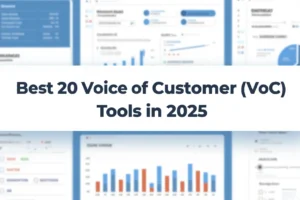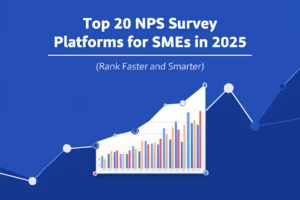Brand tracking is a vital process for understanding how your brand is performing in the market. By keeping an eye on various metrics, you can make informed decisions to maintain or improve your brand’s position. This guide covers everything you need to know about brand tracking and how it differs from brand monitoring.
What is Brand Tracking?
Brand tracking involves regularly measuring and analyzing various aspects of your brand’s performance. This includes assessing brand awareness, perception, and overall market presence. The goal is to gather data that helps you understand how your brand is viewed by your audience and how it is performing compared to competitors.
Brand Tracking vs. Brand Monitoring
While brand tracking and brand monitoring may seem similar, they serve different purposes:
- Brand Tracking: Focuses on long-term trends and patterns in brand performance. It involves collecting data over time to analyze how your brand’s position evolves and to make strategic decisions based on this data.
- Brand Monitoring: Involves real-time tracking of brand mentions and activities, such as social media posts, news articles, and customer reviews. The primary aim is to manage and respond to immediate feedback and potential issues.
Why Is Brand Tracking Important?
Brand tracking is crucial for several reasons, each contributing to the overall success and growth of your brand. Here’s why it matters:
- Understanding Market Position: Brand tracking helps you gauge where your brand stands in the marketplace. By analyzing your brand’s performance compared to competitors, you can determine its strength, weaknesses, and unique position in the industry.
- Evaluating Effectiveness: It allows you to assess the impact of marketing campaigns, promotions, and other branding activities. By tracking how these efforts influence brand awareness and perception, you can identify what works and what needs adjustment.
- Identifying Trends: Brand tracking provides insights into shifting consumer preferences and market trends. Understanding these changes helps you adapt your strategies to stay relevant and meet evolving customer expectations.
- Informed Decision-Making: Access to accurate and up-to-date data enables you to make well-informed decisions. Whether it’s refining your brand strategy or launching new initiatives, having reliable data helps you choose the best course of action.
- Enhancing Brand Loyalty: Monitoring how customers perceive and interact with your brand allows you to address issues promptly and improve customer satisfaction. This, in turn, strengthens brand loyalty and encourages repeat business.
- Benchmarking Performance: Tracking key metrics over time helps you measure progress and set benchmarks for future goals. It provides a clear picture of how your brand’s performance evolves and helps you set realistic targets.
- Managing Brand Reputation: By staying aware of how your brand is perceived and responding to feedback, you can manage and protect your brand’s reputation. Effective brand tracking allows you to address any negative perceptions or issues before they escalate.
- Strategic Planning: Brand tracking data informs long-term strategic planning. Understanding the impact of past actions and current market conditions helps you develop more effective future strategies and allocate resources efficiently.
Overall, brand tracking is essential for maintaining a competitive edge, fostering customer loyalty, and ensuring that your brand remains aligned with its goals and market position. Contact brand tracking agency now to elevate your brand.
What Are the Benefits of Brand Tracking?
Brand tracking offers numerous advantages that can significantly impact the success and growth of your brand. Here’s a deeper look at the key benefits:
Improved Brand Strategy
- Informed Decision-Making: Brand tracking provides valuable data that helps you make strategic decisions based on real insights rather than assumptions. This leads to more effective branding and marketing strategies.
- Refinement of Strategies: By understanding what works and what doesn’t, you can continuously refine your strategies to better meet market demands and achieve your business objectives.
Enhanced Customer Understanding
- Customer Insights: Tracking brand performance helps you gain a deeper understanding of customer perceptions, preferences, and behaviors. This insight allows you to tailor your offerings to better meet their needs.
- Segmentation: You can identify different customer segments and their specific needs, enabling you to target your marketing efforts more effectively.
Better Market Positioning
- Competitive Advantage: By analyzing how your brand compares to competitors, you can identify areas for improvement and differentiation. This helps you strengthen your market position and stand out in a crowded marketplace.
- Targeted Messaging: Understanding your brand’s position allows you to craft messaging that resonates with your target audience and highlights your unique value proposition.
Increased Brand Loyalty
- Customer Satisfaction: Addressing customer feedback and perceptions helps improve their overall experience with your brand. Satisfied customers are more likely to remain loyal and advocate for your brand.
- Long-Term Relationships: Consistently meeting or exceeding customer expectations fosters long-term relationships and encourages repeat business
Effective Resource Allocation
- Optimized Spending: Brand tracking helps you identify which marketing channels and tactics are most effective. This allows you to allocate resources more efficiently and invest in areas that deliver the best results.
- Prioritization: By understanding the impact of various initiatives, you can prioritize efforts that align with your brand’s goals and deliver the highest return on investment.
Benchmarking Performance
- Setting Goals: Tracking key metrics over time enables you to set realistic goals and benchmarks for your brand’s performance. This helps you measure progress and achieve milestones.
- Performance Evaluation: Regularly assessing performance against benchmarks allows you to evaluate the success of your strategies and make necessary adjustments.
Managing Brand Reputation
- Proactive Issue Resolution: Brand tracking helps you identify and address potential issues before they escalate. Monitoring feedback and sentiment allows you to manage your brand’s reputation proactively.
- Crisis Management: In case of negative publicity or crises, brand tracking provides insights into public perception, helping you develop effective response strategies.
Strategic Planning
- Long-Term Success: Insights gained from brand tracking inform long-term strategic planning. By understanding current trends and performance, you can develop strategies that position your brand for future success.
- Adaptability: Staying informed about market changes and customer needs allows you to adapt your strategies and remain competitive in an ever-evolving market.
In summary, brand tracking offers a range of benefits that contribute to a stronger, more resilient brand. It empowers you to make data-driven decisions, improve customer satisfaction, and maintain a competitive edge, ultimately driving long-term success and growth for your brand.
Key Metrics to Consider in Brand Tracking
Tracking the right metrics is essential for gaining valuable insights into your brand’s performance and effectiveness. Here’s a breakdown of key metrics to consider:
- Brand Awareness: Measure how many people recognize and remember your brand.
- Brand Perception: Understand how your brand is viewed in terms of quality, value, and image.
- Market Share: Track your brand’s share in the market relative to competitors.
- Customer Sentiment: Analyze customer feelings and opinions about your brand.
- Brand Engagement: Assess interactions with your brand through social media, website visits, and other channels.
Brand Tracking Methods
Effective brand tracking involves using various methods to gather, analyze, and interpret data about your brand’s performance and market presence. Here are some of the primary methods used in brand tracking:
Surveys and Questionnaire
- Overview: Collecting feedback directly from customers through structured questions about their perceptions, experiences, and attitudes toward your brand.
- Benefits: Provides detailed insights into customer opinions and satisfaction levels. It can be tailored to focus on specific aspects of brand performance.
- How to Use: Deploy surveys via email, online platforms, or in-person. Analyze responses to gauge brand awareness, perception, and customer satisfaction.
Social Media Analytics
- Overview: Monitoring social media platforms to track mentions, interactions, and sentiment related to your brand.
- Benefits: Offers real-time insights into public perception and engagement. Social media analytics can reveal trends, identify influencers, and measure the impact of campaigns.
- How to Use: Use social media listening tools and platforms (e.g., Hootsuite, Brandwatch) to track keywords, hashtags, and brand mentions. Analyze sentiment and engagement metrics to assess brand health.
Web Analytics
- Overview: Analyzing data from your website to understand user behavior, traffic sources, and engagement levels.
- Benefits: Provides insights into how users interact with your brand online, including website performance, visitor demographics, and content effectiveness.
- How to Use: Utilize tools like Google Analytics to track metrics such as page views, bounce rates, average session duration, and conversion rates. Analyze these metrics to evaluate the effectiveness of your online presence.
Sales Data
- Overview: Reviewing sales figures to assess the financial impact of branding efforts and market demand.
- Benefits: Indicates how brand activities influence sales performance. Helps in understanding the relationship between marketing efforts and revenue growth.
- How to Use: Analyze sales trends, compare sales performance over time, and correlate changes with branding campaigns or market events.
Competitor Analysis
- Overview: Comparing your brand’s performance with that of competitors to identify strengths, weaknesses, and market positioning.
- Benefits: Provides context for your brand’s performance relative to competitors. Helps identify opportunities for differentiation and improvement.
- How to Use: Gather data on competitors’ market share, brand positioning, and marketing strategies. Use this information to benchmark your brand’s performance and refine your strategies.
Focus Groups
- Overview: Conducting group discussions with selected individuals to gain deeper insights into their perceptions and attitudes toward your brand.
- Benefits: Offers qualitative insights into customer opinions, motivations, and reactions. Provides in-depth understanding beyond quantitative data.
- How to Use: Organize focus groups with diverse participants. Use trained moderators to guide discussions and analyze the qualitative feedback to gain actionable insights.
Customer Feedback and Reviews
- Overview: Collecting and analyzing customer reviews, ratings, and feedback from various platforms.
- Benefits: Provides direct insights into customer experiences and satisfaction. Helps identify areas for improvement and highlights strengths.
- How to Use: Monitor review sites (e.g., Trustpilot, Yelp) and customer feedback channels. Analyze common themes and sentiments to gauge overall customer satisfaction and brand perception.
Brand Health Metrics
- Overview: Tracking specific metrics related to brand health, such as brand equity, loyalty, and reputation.
- Benefits: Provides a comprehensive view of your brand’s overall health and performance. Helps in making strategic decisions to strengthen brand value.
- How to Use: Measure metrics like brand equity, customer loyalty, and Net Promoter Score (NPS). Analyze these metrics to assess brand strength and make informed adjustments.
Brand Tracking Software
- Overview: Utilizing specialized software to automate and streamline brand tracking processes.
- Benefits: Provides advanced analytics, real-time data, and comprehensive reporting. Simplifies the tracking of multiple metrics and channels.
- How to Use: Choose software solutions that fit your needs (e.g., Brandwatch, Sprout Social). Use these tools to gather and analyze data across various platforms and metrics.
Media and Public Relations Tracking
- Overview: Monitoring media coverage and public relations activities to understand their impact on brand perception.
- Benefits: Helps assess the effectiveness of media campaigns and PR efforts. Provides insights into how media and public relations influence brand image.
- How to Use: Track media mentions, press releases, and PR coverage. Analyze the tone, reach, and impact of media activities on brand perception.
By employing a combination of these methods, you can gain a well-rounded understanding of your brand’s performance, make data-driven decisions, and continually enhance your brand’s market presence.
How Often to Conduct Brand Tracking?
The frequency of brand tracking depends on your specific needs and industry:
- Monthly: For fast-moving industries or brands with frequent changes in market dynamics.
- Quarterly: For more stable industries where trends change less frequently.
- Annually: For long-term evaluations and major strategic reviews
Conclusion
Brand tracking is a crucial practice for maintaining and improving your brand’s market position. By understanding the differences between brand tracking and brand monitoring, recognizing the benefits, and using the right metrics and methods, you can make informed decisions that drive your brand’s success. At Pearl Lemon Experiences, our team is here to help you implement effective brand tracking strategies and achieve your branding goals.
FAQs
Brand tracking software automates and streamlines the process of tracking various brand metrics, providing advanced analytics and real-time data. Brand tracking, on the other hand, refers to the overall process of monitoring and analyzing brand performance, which may or may not involve the use of software tools.
Use brand tracking data to identify strengths and weaknesses in your brand’s performance. Adjust your marketing strategies based on insights related to customer preferences, market trends, and campaign effectiveness. Data-driven decisions can lead to more targeted and effective marketing efforts.
If brand tracking reveals negative trends, analyze the underlying causes and develop strategies to address them. This may involve improving customer service, adjusting marketing messages, or addressing product issues. Continuous monitoring and adjustment will help mitigate negative trends and improve overall brand performance.
Yes, small businesses can benefit from brand tracking by gaining insights into brand performance, understanding customer perceptions, and making informed decisions to improve their market presence. Brand tracking helps small businesses compete effectively and build strong customer relationships.




